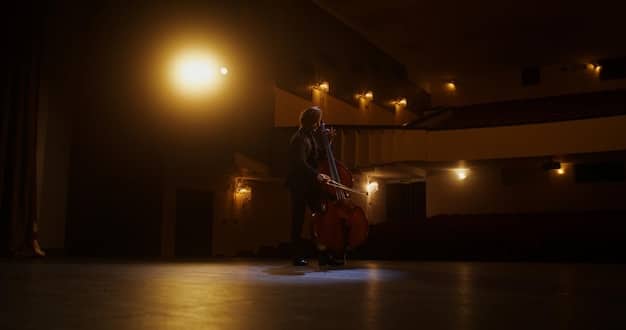Emerging Artists’ Guide to Music Distribution: Choosing the Right Platform

Navigating the complex landscape of music distribution is crucial for burgeoning artists seeking to reach listeners, requiring careful platform selection balancing global reach, artist control, and revenue opportunities to foster a sustainable career.
For any musician, the dream often includes sharing their art with the world. However, turning that dream into a reality involves more than just crafting compelling melodies and profound lyrics; it requires understanding how to effectively get your music to listeners. This comprehensive Emerging Artists’ Guide to Music Distribution: Choosing the Right Platform delves into the intricacies of digital music distribution, offering strategies and insights to help you make informed decisions in a rapidly evolving industry.
Understanding the music distribution landscape
The digital age has revolutionized how music reaches its audience, moving from physical stores to countless streaming services and online retailers. For an emerging artist, this shift presents both immense opportunities and significant challenges. Understanding this new landscape is the first critical step toward building a successful career.
Historically, artists relied on record labels to handle the complex process of manufacturing, distributing, and marketing physical albums. Today, the power rests increasingly with independent distributors and artists themselves, thanks to digital platforms. This democratization of distribution means anyone can upload their music, but it also intensifies the competition for listeners’ attention.
The role of digital distributors
Digital music distributors act as intermediaries, bridging the gap between artists and the myriad of digital music stores and streaming platforms like Spotify, Apple Music, and Amazon Music. They handle the technical aspects of delivering your audio files and metadata, ensuring your music is available globally. Choosing the right distributor means finding a partner that aligns with your artistic and business goals.
- Reach: Does the distributor have strong relationships with all major platforms as well as niche ones relevant to your genre?
- Reporting: Do they provide transparent and timely sales and streaming data, crucial for understanding your audience?
- Support: Is customer service responsive and helpful, assisting with technical issues or rights management?
Without these services, individual artists would face immense hurdles trying to upload their music directly to each platform, a process often reserved for major labels or requiring unique API integrations. Distributors streamline this, allowing artists to focus more on their craft and less on the logistics.
Moreover, distributors often offer additional services, such as publishing administration, YouTube Content ID, and sync licensing opportunities, which can be invaluable for an artist looking to maximize their revenue streams and protect their intellectual property. The landscape is dynamic, with new platforms and technologies constantly emerging, making a knowledgeable distributor a vital ally.
Key factors in choosing a distribution platform
Selecting the ideal music distribution platform is a pivotal decision that can significantly impact an emerging artist’s career trajectory. Beyond simply getting your music online, consider how a platform supports your long-term growth and financial stability. This requires a balanced evaluation of various factors, moving beyond just the immediate appeal.
The “best” platform isn’t a universal truth; it depends entirely on your specific needs as an artist. Are you focused purely on digital streaming, or do you have physical releases planned? What level of control over your music do you wish to maintain? These questions guide your decision-making process.
Understanding fee structures and royalty splits
One of the most immediate and often confusing aspects of choosing a distributor is understanding their payment models. Most platforms operate on either a subscription-based model or a commission-based model, or sometimes a hybrid of both.
- Subscription Model: Platforms like DistroKid typically charge an annual fee to distribute unlimited music. This can be cost-effective for artists releasing frequently.
- Commission Model: Services like TuneCore or CDBaby may take a percentage of your royalties (e.g., 9-15%) but might offer free uploads or charge per release. This could be better for artists with fewer releases or those unsure about future output.
- Hybrid Models: Some distributors combine elements, such as a low annual fee plus a smaller commission, aiming to offer flexibility.
Crucially, investigate the royalty splits. While distributors take their cut, remember that the streaming services themselves also take a significant portion of the revenue generated. Your distributor should make it clear exactly how much of the remaining share you receive and when you can expect payouts. Transparency here is non-negotiable for financial planning and understanding your income potential.
Always read the fine print regarding hidden fees for services like UPC codes, ISRC codes, or takedowns. These seemingly small charges can accumulate, especially for artists with a tight budget. A clear, upfront fee structure saves unpleasant surprises down the line.
Major distribution platforms: a comparative analysis
With numerous options available, it’s essential for emerging artists to understand the nuances of the most prominent music distribution platforms. Each offers distinct advantages and caters to different artist needs, making a direct comparison invaluable before committing.
We’ll look at some of the industry leaders, evaluating their core offerings, pricing structures, and unique features. This analysis aims to provide a clear overview, helping you narrow down your choices based on your specific requirements rather than generalized recommendations.
DistroKid: unlimited, affordable uploads
DistroKid is a popular choice for artists who release music frequently due to its unlimited annual upload model. For a single annual fee, you can release as much music as you want, making it highly cost-effective for prolific creators.
- Pros: Unlimited uploads, fast distribution to major platforms, 100% artist royalty payout (after the subscription fee and platform cuts), easy-to-use interface, various add-on services like YouTube Content ID.
- Cons: Lacks some of the more in-depth analytical tools or personalized support found on other platforms, some add-on services cost extra.
DistroKid’s appeal lies in its simplicity and efficiency. It’s often recommended for artists just starting out who want to get their music onto all major streaming services quickly and without worrying about per-release costs. Its straightforward approach aligns well with artists who prefer a DIY ethos.
TuneCore: retain 100% of your earnings per release
TuneCore operates on a different model, charging a per-release fee while allowing artists to keep 100% of their royalties from streaming services. This can be attractive to artists who have fewer, but potentially higher-earning, releases.
- Pros: Keeps 100% of royalties, strong reputation, comprehensive analytics and reporting, offers publishing administration services, YouTube Content ID, sync licensing opportunities.
- Cons: Per-release fees can add up for frequent releases, some users report a less intuitive interface than competitors, customer support can sometimes be slow.
TuneCore emphasizes artist ownership and full royalty retention, distinguishing itself from percentage-based models. Its extensive suite of additional services, particularly publishing administration, makes it a strong contender for artists looking for more comprehensive support beyond basic distribution.
CDBaby: one-time fee per release, physical distribution too
CDBaby is unique for offering a one-time fee per release, meaning you pay once, and your music remains distributed forever. It also stands out by offering physical distribution (CDs and vinyl) in addition to digital.

- Pros: One-time fee for lifetime distribution, physical distribution options, offers sync licensing, YouTube Content ID, publishing administration.
- Cons: Takes a 9% commission on digital sales, some users find the interface a bit dated, reporting might not be as granular as other platforms.
CDBaby is a versatile option, particularly for artists who want to offer both digital and physical formats of their music. Its lifetime distribution model offers peace of mind, though the commission on digital sales is a factor to consider alongside the upfront fee. It appeals to artists seeking a more traditional, yet still independently focused, distribution path.
Beyond distribution: value-added services
While getting your music onto major platforms is the primary function of a distributor, the true value often lies in the additional services they offer. For an emerging artist, these supplementary tools can be instrumental in building a career, extending reach, and maximizing revenue beyond mere streams.
Choosing a distributor that provides robust value-added services means gaining a partner in your long-term success, rather than just a pipeline for your songs. Evaluating these extra features is as important as comparing basic distribution fees.
Publishing administration and sync licensing
Publishing administration involves collecting royalties generated from your musical composition (the song itself, not just the recording) whenever it’s performed publicly, broadcast on TV/radio, or streamed. This can be a complex area to navigate independently, making a distributor’s service invaluable.
- Performance Royalties: Collected from public performances in venues, radio airplay, and streaming services.
- Mechanical Royalties: Generated when your song is reproduced (e.g., streaming, downloads, physical copies).
- Sync Licensing: The opportunity to license your music for use in films, TV shows, commercials, video games, or other visual media. This can provide significant upfront fees and expose your music to new audiences.
Platforms that offer publishing administration ensure you capture these crucial revenue streams that many artists unknowingly leave on the table. Sync licensing, in particular, can be a game-changer, offering both financial gain and invaluable exposure. Some distributors have dedicated teams or partnerships to pitch your music for these opportunities.
YouTube Content ID and piracy protection
For many artists, YouTube is a primary platform for discovery and engagement. Ensuring you are monetizing all uses of your music on YouTube is crucial. Content ID is YouTube’s automated system that identifies and claims content that includes your music, even if uploaded by others. Your distributor can administer this on your behalf.
Beyond YouTube, some distributors offer broader piracy protection services, scanning the internet for unauthorized uses of your music and issuing takedown notices. This helps protect your intellectual property and ensures that legitimate channels are the primary sources of your music.
The digital age, while enabling wider reach, also presents challenges regarding copyright infringement. A distributor that actively helps protect your rights and monetize your content across various platforms adds substantial value, allowing you to focus on creating new music with greater peace of mind.
Marketing and promotion support
Having your music distributed worldwide is only half the battle; getting people to listen is the other. Many distribution platforms recognize this and offer various marketing and promotional tools to help emerging artists cut through the noise. These services can range from basic analytical insights to advanced promotional campaigns.
While a distributor’s primary role isn’t marketing, the ancillary services they provide can significantly amplify an artist’s independent efforts. It’s crucial to assess what level of support is available and how it aligns with your own marketing strategy.
Pre-save links and release campaigns
Generating excitement before a release is vital. Pre-save links allow listeners to save your upcoming music to their preferred streaming service before its release date, ensuring it automatically appears in their library the moment it goes live. This is a powerful tool for building momentum and maximizing first-day streams.
Many distributors provide tools to create these links effortlessly. Some even integrate them with smart marketing campaigns, allowing you to collect fan data, run contests, or offer exclusive content to those who pre-save. Look for platforms that simplify the creation of these links and offer customization options.
Beyond pre-saves, some distributors offer promotional campaign tools or partnerships with editorial playlist curators. While these often come with additional costs, they can provide a much-needed boost for new releases, helping to secure placements on influential playlists or gain visibility on platform homepages. Evaluate if these services are transparent about their effectiveness and costs.
Analytics and audience insights
Understanding who is listening to your music, where they are, and how they engage with it is paramount for effective marketing and touring. Robust analytics dashboards are a key feature to look for in a distribution platform.

These dashboards provide data on:
- Streaming numbers: Which songs are performing best on which platforms?
- Geographic data: Where are your listeners located? This informs touring decisions and targeted advertising.
- Demographics: Age, gender, and other insights into your audience, helping tailor your messaging.
- Listener behavior: How often do listeners return? Do they complete songs or skip them?
Accurate and easy-to-understand analytics empower artists to make data-driven decisions about their music, marketing, and live performances. A distributor that provides granular insights, rather than just high-level numbers, gives you a significant advantage in strategizing your next moves. These insights transcend simple distribution, becoming vital components of artist development.
Emerging trends and what to look for in 2025
The music industry is in a constant state of flux, driven by technological advancements and shifting consumption habits. For emerging artists, staying ahead of these trends is not just about adopting new tools, but understanding how they reshape the landscape of music distribution and audience engagement. As we look towards 2025, certain trends are becoming increasingly prominent and will largely influence how artists connect with their fans and monetize their work.
The platforms that thrive will be those that adapt quickly to these changes, offering artists the flexibility and tools needed to navigate an ever-evolving digital ecosystem. Staying informed will allow you to select a distribution partner capable of meeting future demands.
Web3, NFTs, and direct-to-fan models
The rise of Web3 technologies, particularly NFTs (Non-Fungible Tokens), is beginning to disrupt traditional fan engagement and monetization models. For artists, NFTs offer a novel way to create unique digital assets that represent music, artwork, or experiences, allowing for direct-to-fan sales without intermediaries.
In 2025, we can expect more distribution platforms to integrate Web3 capabilities, offering artists tools to mint and sell NFTs directly to their audience. This bypasses traditional royalty structures and creates new forms of digital ownership and community building. Artists could sell direct stakes in their future royalties, offer exclusive content only accessible via an NFT, or create unique digital collectibles that foster deeper connection with superfans.
This shift emphasizes a more direct relationship between artist and fan, giving artists greater control over their intellectual property and revenue. Look for distributors who are actively exploring or implementing Web3 integrations, indicating a forward-thinking approach to artist empowerment.
AI-powered tools and personalized artists services
Artificial intelligence is rapidly changing how music is created, discovered, and distributed. In 2025, expect AI to play a larger role in distribution platforms, offering artists more personalized insights and streamlined processes.
AI could:
- Optimize release timing: Analyzing fan data to suggest the best day and time to release new music for maximum engagement.
- Automate metadata tagging: Using AI to intelligently tag music with genres, moods, and styles, improving discoverability on streaming platforms.
- Generate marketing copy: Assisting artists in creating compelling social media posts and email campaigns for new releases.
- Personalized fan outreach: Identifying superfans and suggesting targeted ways for artists to engage with them.
Beyond these, AI might also be used for more sophisticated fraud detection to protect artists’ earnings from artificial streaming. Platforms that invest in AI-driven tools will offer artists a competitive edge, allowing them to work smarter, not just harder, in their career development.
The future of music distribution is likely to be characterized by increasing directness between artists and fans, powered by innovative technologies that streamline processes and open up new monetization avenues. Being aware of these trends will help emerging artists choose a platform that is not just current, but future-proof.
| Key Aspect | Brief Description |
|---|---|
| 🚀 Platform Reach | Ensure global distribution to major streaming services and niche platforms. |
| 💰 Fee Structure & Royalties | Compare subscription vs. commission models and transparent royalty splits. |
| 📈 Value-Added Services | Look for publishing admin, sync licensing, and YouTube Content ID. |
| 📊 Analytics & Support | Assess data reporting for audience insights and reliable customer service. |
Frequently asked questions (FAQs)
▼
Music distribution is the process of getting your recorded music onto various digital platforms like Spotify, Apple Music, and Amazon Music, as well as physical stores if applicable. Distributors act as intermediaries, handling the technical delivery and royalty collection on behalf of the artist.
▼
Yes, absolutely. While some platforms offer direct artist uploads, a distributor is crucial for reaching the vast majority of streaming services and online stores. They streamline the process, manage metadata, and help collect royalties, which would be impossible for an independent artist alone.
▼
The main models are subscription-based (annual fee for unlimited uploads, like DistroKid) and commission-based (distributor takes a percentage of your royalties, like TuneCore’s per-release model). Some platforms offer hybrids. Artists should choose based on release frequency and desired royalty retention.
▼
Publishing administration involves collecting royalties from the composition itself, separate from the recording. These include performance and mechanical royalties. It’s crucial because it ensures you get paid when your song is publicly performed, broadcast, or reproduced, maximizing your income from your intellectual property.
▼
Most reputable distributors offer services like YouTube Content ID, which automatically identifies and claims your music on YouTube, monetizing unauthorized uploads. Some also provide broader piracy protection, issuing takedown notices for infringing content across the internet, safeguarding your creative work.
Conclusion
The journey for an emerging artist is multifaceted, and understanding the landscape of music distribution is a cornerstone of building a sustainable career. By carefully evaluating distribution platforms based on their reach, fee structures, value-added services, and future-readiness, artists can make informed decisions that extend their music’s reach and protect their interests. Choosing the right partner means not just getting your music out there, but setting the stage for long-term growth and connection with your audience in an ever-evolving industry.





